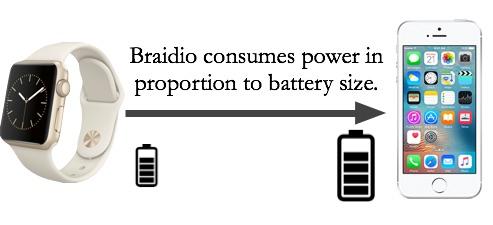Radio Technology Lets Wearables Piggyback on Power from Larger Devices
New radio technology from researchers at the University of Massachusetts Amherst allows low-power devices to run by piggybacking on power from larger devices
September 9, 2016
New radio technology from researchers at the University of Massachusetts Amherst allows small and low-power devices like wearables to run by piggybacking on power from larger devices with which they communicate.
Calling their technology “Braidio” for the braid of radios that can be connected, Professor Deepak Ganesan and graduate students in the College of Information and Computer Sciences at UMass said their method for offloading energy could extend battery life hundreds of times in some cases for mobile devices such as fitness trackers and smart watches.
The technology itself is fairly simple, using a Bluetooth Low Energy-style active radio modified using a few additional off-the shelf components, researchers said in a paper, "Braidio: An Integrated Active-Passive Radio for Mobile Devices with Asymmetric Energy Budgets," provided to Design News by Ganesan. The result is a low-power, tightly integrated, low-cost radio that can operate as an active and passive receiver, they said.

New radio technology from researchers at the University of Massachusetts Amherst allows small and low-power devices like wearables to run by consuming power from larger devices with which they communicate. (Source: University of Massachusetts Amherst/Deepak Ganesan)
“When these modes operate in an interleaved (braided) manner, the end result is a power-proportional low-power radio that is able to achieve 1:2,546 to 3,546:1 power-consumption ratios between a transmitter and a receiver, all while operating at low power,” according to the paper, which researchers also presented at the recent Association for Computing Machinery’s special interest group on data communication (SIGCOMM) conference in Brazil.
Battery size in devices is proportional to size in a similar way that computational power is, according to Ganesan, who compared the ability for devices to offload communication power to how computational power can be offloaded to the cloud.
"We take for granted the ability to offload storage and computation from our relatively limited personal computers to the resource-rich cloud," he said. "In the same vein, it makes sense that devices should also be able to offload how much power they consume for communication to devices that have more energy."
To design the type of passive backscatter communication technology is daunting, however, because while it is inherently designed to be ultra-low power on the tag, it “uses a rather bulky and power-hungry reader that consumes watts of power, not milliwatts,” Ganesan and the team wrote in the paper, which also explains how they handled the problem.
”For carrier offload to be practical, we need to be able to move the carrier across endpoints while incurring low-power consumption,” researchers wrote. “We tackle this problem through an innovative architecture that integrates the key components of both active and passive radios, in particular carrier generation and self-interference cancellation, while still operating at an end-to-end power consumption comparable to active radios. Our key innovation is the use of passive methods to cancel self-interference, which paves the way for a low-power, yet high-performance, end-to-end design.”
READ MORE ARTICLES ON SOLAR ENERGY:
In other words, the team enhanced Bluetooth with the ability to operate in a similar manner to radio-frequency identification (RFID), which operates asymmetrically, with the reader doing most of the work and paying the majority of the energy cost of communication. Meanwhile the tag, typically embedded in a smaller device or object, is extremely power-efficient, researchers said.
When a device has sufficient energy, Braidio operates like a standard Bluetooth radio; however, it operates like RFID when energy is low, offloading energy use to a device with a larger battery when needed. Thus, when a wearable is equipped with a Braidio, it can work together with a smartphone to proportionally share the energy consumed for communication, researchers said.
The team will continue to develop the Braidio technology, focusing on ideas to improve and enhance it, as well as eye licensing options for the technology, Ganesan said.
Elizabeth Montalbano is a freelance writer who has written about technology and culture for more than 15 years. She has lived and worked as a professional journalist in Phoenix, San Francisco, and New York City. In her free time she enjoys surfing, traveling, music, yoga, and cooking. She currently resides in a village on the southwest coast of Portugal.
About the Author(s)
You May Also Like



